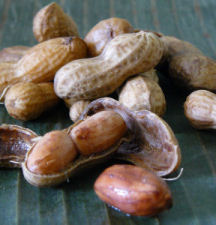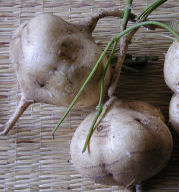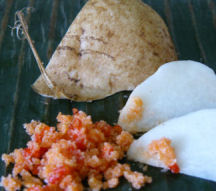 Even though I shop at a year-round farmers market, Thanksgiving marks a special time of the year. It's not only because I'm shopping for the turkey holiday feast or that autumn's cool weather bounty of cauliflower, carrots and broccoli have started arriving. It's more because I go into a wistful mode about certain vegetables.
Even though I shop at a year-round farmers market, Thanksgiving marks a special time of the year. It's not only because I'm shopping for the turkey holiday feast or that autumn's cool weather bounty of cauliflower, carrots and broccoli have started arriving. It's more because I go into a wistful mode about certain vegetables.
After Thanksgiving, the weather turns, fewer customers come out, and the number of vendors each week declines by thirty to fifty percent. Who wants to brave the cold and rain to sell to a few diehard regulars? I certainly wouldn't if I were KT Farms, Hmong farmers who drive from Fresno, three hours away, to the coast. All summer and into the early fall, I prepare myself for the inevitable by patronize their stall for eggplant, okra, sinqua ridged squash every Saturday. But as Thanksgiving approaches, no matter how much of those hot-weather veggies I've eaten, I start thinking that I'll never see them again. Okay, so that's not realistic. It's more like I'll never see them again that super fresh - until KT Farms comes back in April or May.
As Thanksgiving approaches, I even start missing things that I hadn't paid attention to all season long. Vegetables that I'd glossed over as I sorted through the piles of Chinese, Japanese, Indian, Italian and American eggplants suddenly hold huge appeal. This year, as with every year, I realize that I'd taken the peanuts and jicama for granted for months. (It's a vicious circle that I can't seem to annually escape from.)
 I come home with a bag of peanuts and another of baby jicama. The peanuts are a bit damp, having been dug up just the day before. The jicama are fist-sized with thin, soft skin that can scraped off with a fingernail. Coincidentally, both peanut and jicama are legumes - members of the bean family, and native to the Americas. European traders brought them to Asia in the sixteenth century where they became extremely popular and eventually staple foods.
I come home with a bag of peanuts and another of baby jicama. The peanuts are a bit damp, having been dug up just the day before. The jicama are fist-sized with thin, soft skin that can scraped off with a fingernail. Coincidentally, both peanut and jicama are legumes - members of the bean family, and native to the Americas. European traders brought them to Asia in the sixteenth century where they became extremely popular and eventually staple foods.
In my kitchen, I savor these precious treasures in common Vietnamese fashion. I boil the peanuts and snack on the buttery, nutty beans over the course of a week's time. The jicama get peeled and cut into small wedges and enjoyed with a dip in chile salt that enhances the tuberous root's natural sweetness. (This savory-sweet combination is found in many tropical cuisines like that of Mexico.)
These simple pleasures remind me not to neglect them next year. But I will. Maybe eating them right before they disappear makes me appreciate them even more? I'll never know because this is an annual ritual that I can't give up.
Boiled Fresh Peanuts
Put the peanuts in a pot with plenty of water. The peanuts will bob around so aim for about 5 inches of water. Add a generous amount of salt. I put a tablespoon in when boiling peanuts in 3 to 4 quarts of water. Bring to a boil and keep them going fast and furious for an hour. It takes a while because the water has to penetrate the shell so this isn't like cooking fresh shell beans.
Check on the water about 3 times during cooking to see if you need to add extra water. To check for doneness, eat one, but remember to rinse it in cold water to cool before you try. Drain and set aside to cool. Refrigerate, if you like, or start cracking the shells to get to the beans.
Jicama and Chile Salt
Peel the jicama and cut into wedges or sticks - whatever shape you like. In a mortar and pestle, pound together a chopped Thai chile, 1 teaspoon kosher salt, and ¼ teaspoon sugar to create a slightly wet, pinkish-orange mixture. Use a spatula to scrape the chile salt out onto a small dish and serve with the jicama.
You can certainly use jicama from regular supermarkets for this snack. Or try a tart fruit like a green apple or green mango.
Happy Thanksgiving.

















Simon Bao says
Wait wait, the weather turns *after* Thanksgiving???
Andrea, that weather here turned a while ago and by this weekend, the farmers' markets will be selling Christmas trees and wreaths and garlands. Here along the Mid-Atlantic coast, all that's left is some root veggies, cabbages, and brussels sprouts. And I guess the last of the apple cider.
Happy Thanksgiving to you too. 🙂
Andrea Nguyen says
Simon, you should live in California. We barbecue year round and yes, where I am, the weather gets extra nasty after Thanksgiving. We're a bit chillier now but it's not as bad as it normally gets after T-day. Hey, we grow most of the Brussel sprouts for the country because we have a longer growing season.
CD says
Andrea, do you have any idea what's in the "MSG salt" that's served with fruits in Vietnam?
Nate says
63*F and sunny right now in San Jose. Beautiful Fall day. 😀
Ever coated the jicama with li hing powder? Yum.
Andrea Nguyen says
Nate, I've never done jicama with salty/sweet/sour li hing plum powder but am sure it's good that way! I was a li hing (xi mui) sucker in my youth.
Thuy-Hoa Nguyen says
Hi Andrea,
I need your help .I has been searching for a recipe of bamh tro.I could not find one .It seems to be a mystery to me. It was one of my chidhood favorite treats from my mother.I peeled off the bamboo leaves wrapper and there was a clear yellow golden sweet rice which was cooked until softened .Banh tro is usually eaten with ginger syrup. Thank you very much .I realy enjoy your website .Thuy-hoa.Canada.
nike shox NZ says
Write your blog is very good! You are willing to share with me your experience it? Very proud to see this article ah
coach outlet says
A look at things from other people's ideas, the activity of mind to know other people who never have to worry for their future.
treatment of piles says
This is a great article. Wow, so many of these things I never thought of before. I often read posts, even on this site, and I think they are great, but I don’t take the time to leave a comment. I’m going to start leaving more comments for sure.
Monster Beats sale says
Every man is his own worst enemy.
Discount Red Bottom shoes says
Blood is thicker than water.
Beats by Dre says
Whom the gods love die young.
Canada Goose says
Nature has given us two ears, two eyes, and but one tongue, to the end that we should hear and see more than we speak.
Mr. Cooking Grill says
it's already gorgeous looking!! Love your work (and research), you're a true food writer whom I absolutely look up to. 🙂
marlon says
well your work is pretty good and i really like your post . .every thing in the post is awesome .